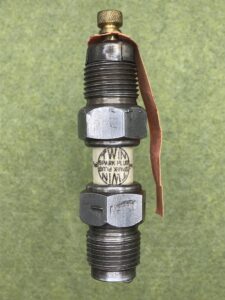Spark Plug History
There are over 1500 spark plug design patents registered with the United States Patent Office up through 1930 and over 6000 spark plug names on the club’s Master list of plug names.
QUICK HISTORY OF THE SPARK PLUG
The actual evolution of the modern day spark plug came about as a solution to the problem with early flame and ignitor ignitions on internal combustion engines. There have been several materials that have evolved as insulation materials. Some materials that have been used are mica, stone and several different kinds of improved porcelain. A lot of early forms of porcelain were not designed to handle the extreme hot and cold changes that engines demanded. Some insulated materials were very porous and would absorb oils and soot easily. This would make for a short life as they would foul out quickly. Gasoline in the early days wasn’t as refined as it is today. It contained more oils and was closer to today’s kerosene.
In 1915 a major improvement in porcelain was “775” porcelain, by the Frenchtown Porcelain Company. This new formula produced porcelain that would hold up to heat changes with less absorption of oil. Since that time improvements have continued on porcelain designs. Dr. Joseph Jeffery’s discovery of silimanite in 1933 gave spark plugs a longer life. This was another major improvement in the porcelain design.
Over the years, companies have tried to come up with unique designs to be used as selling points for their
spark plugs. Some of the unique ideas included:
- Quick Detachable – by moving a lever 1/4 of a turn, you could remove the center for quick easy cleaning without tools;
- Double Ended Plugs – could be turned over when one end was fouled and still have a plug that worked;
- Breathing Plugs – were designed to allow clean, cool air to be sucked in over the hot end of the porcelain, which would assist in further burning away of deposits;
- Priming Plugs – allowed you to put a small amount of gas into the cylinder for easy starting;
- Coil Plugs – where the coil and the plug were actually combined into a one piece unit;
- Intensified Plugs – having a second firing gap, that was advertised as allowing the plug to “fire hotter and longer”.





